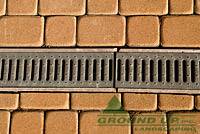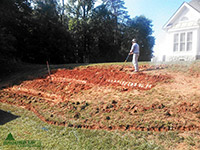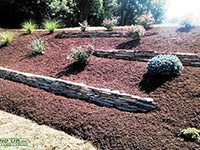- Home
- About Us
- Services
- Landscape Design
- Build Services
- Landscape Installation
- Hardscaping
- Drainage/Erosion Solutions
- Professional Lawn Care
- Seeding/Sod Installation
- Pruning
- Tree Removal
- Mulch
- Landscape Clean-Up
- Retaining Walls
- Dry Stacked Stone
- Paver Driveways/Sidewalks
- Decks/Patios
- Ponds/Fountains
- Hauling & Plant Delivery
- Excavation
- Landscaping Ideas
- Improving the Curb Appeal of Your Front Yard
- Options for Cracked, Broken, Uneven Walkway
- Areas of High Maintenance
- Designing for Small Yards
- Areas Where Grass Will Not Grow
- Water Pooling Near House Foundation
- Water Pooling in Yard
- Alternatives to Mowing Steep Slopes
- No Space (or Time) for a Veggie Garden
- Water Feature Too Difficult to Maintain
- Contact Us
Call Us:
540-772-4722
Quality Landscaping from the Ground Up
Commercial and Residential Landscaping Services
Drainage / Erosion Solutions

Do you have these or similar problems in your yard:
- Rain water from downspouts pooling under your house or other structures on your property
- Water pooling in the same areas of your lawn or planting beds whenever it rains
- Gullies cut by stormwater runoff
- Banks, steep slopes, lawn or garden areas where nothing will grow
- Water accumulating on walks, patios or driveways (which becomes ice in winter months)
- Soil washing out and accumulating on walks, patios or driveways
IF YOU’RE EXPERIENCING ANY OF THESE OR OTHER DRAINAGE/EROSION ISSUES, GROUND UP CAN TAILOR SOLUTIONS FOR YOUR LANDSCAPE WITH ONE OR MORE OF THE METHODS BELOW:
Landscaping Idea #6
For Front & Back Yards
Problem:
Water Pooling Near Your House’s Foundation
Solution:
Note: Water that doesn’t drain away from the crawl space or basement of a house can cause structural damage.
Depending on the amount and location of the pooling water, solutions can include:
- Correcting the grade around the house to enable water to flow away from the foundation.
- Installing subsurface drainage (drainage tile or French drain) to direct water away from the foundation.
- Installing a swale to intercept water before it reaches the foundation and direct it elsewhere.
- Any combination of the above.
For other landscape issues and solutions, click here to be directed to our LANDSCAPING IDEAS page.
Subsurface Drainage – When drainage issues outside your home force water to flow through the seams between the foundation wall and the floor of a basement or through the cracks in the basement wall itself, subsurface drainage may be necessary. Drainage systems consisting of drain tiles or perforated pipes surrounded by gravel and installed in a sloping trench can help move the water away from the foundation. These systems of tiles or perforated pipes allow the water to flow from the problem area to other areas of your yard where water can be absorbed or released into existing above-ground drainage systems. Citation: Hannebaum, Leroy G. Landscape Design: A Practical Approach.5th ed. New Jersey: PrenticeHall, 2002. Print.
Retaining Walls – Retaining walls are often necessary here in the greater Roanoke, VA area to transform sloped areas of the yard to more level spaces that can accommodate more uses, such as parking, outdoor grilling/dining, lounging, outdoor games, lawn or garden maintenance, and safer easier access in and around the yard. They can also be used to hold back soil to address soil erosion. READ MORE…
 Prep work for retaining walls to address erosion |
 Retaining walls, plants and mulch complete |
Mulch – Depending on the slope of the area involved, another option for controlling erosion might be installing stone or other types of mulch. You can also create a rock garden on a slope that not only helps prevent erosion but can accommodate a collection of plants.
For more information on decorative stone and mulch available through our industry partners, visit any of the links below:
- STONE
- Marshall Stone – See stone under “Aggregates” at http://www.marshallstone.com/product-line/
- Mulch –n – More: See decorative stone under “Dec. Stone” at http://www.mulchnmore.org/
- MULCH
- Marshall Stone: http://www.marshallstone.com/product-line/mulches-soils/
- Mulch –n – More: See various types of mulch under “Mulch” at http://www.mulchnmore.org/
Grading/Excavating – Two other methods often employed to resolve drainage/erosion problems are grading and excavating. Generally speaking: “Grading involves physical movement of soil from one area of the site to another. When earth is added to an area, it is called fill. When earth is removed or excavated from an area, it is called cut.“ To reduce costs, soil that is excavated on a site is used as fill in other areas of the same site whenever possible. Citation: Booth, Norman K., and James E. Hiss. Residential Landscape Architecture: Design Process for the Private Residence. 6th ed. Boston: Prentice Hall, 2012. Print.
When the drainage problem is water pooling around or under your house, grading may be the solution. Often the grading that is done after home construction is insufficient or incorrect. Grading done properly allows rain water from your roof and gutters, sidewalks, and driveways to drain away from your home preventing many potential problems.
The many benefits of proper grading include:
- Keeping water from draining and pooling under your house,
- Eliminating pools in your yard where mosquitoes can breed,
- Preventing your landscape plants from injury or death due to overly wet soils,
- Alleviating erosion, and
- Improving your lawn's appearance.
Grading/excavating is necessary when slopes are too steep for safe mowing or erosion prevents anything from growing and soil is washed away with rainfall or irrigation. Grading/excavating is also needed when installing retaining walls, steps, walks, or driveways in sloped or uneven terrain. Adding features such as steps and walks can make it easier for you to access all parts of your yard safely so you can get more enjoyment out of your outdoor living space. Visit our GRADING/EXCAVATING and HARDSCAPING Web pages for more information.
Hydro-Seeding – Another option for planting slopes or large areas is hydro-seeding. Hydro-seeding involves spraying a slurry mix of seed, mulch, fertilizer and bonding agent onto the planting area. This process has many advantages over sod or other (dry) seed broadcast methods:
HYDRO-SEEDING VS. SOD
- More cost effective than installing sod.
- Fewer problems associated with compatibility of soil that comes with the sod.
- Not limited to turf grasses – the mix can include: native grasses, wildflowers, erosion control mixes, etc.
HYDRO-SEEDING VS. DRY SEED BROADCASTING
- Faster germination due to the nutrients in the fertilizer and the decomposition of the mulch.
- No weed seeds from the loose straw or straw blankets typically used to cover dry seed.
- No nitrogen leaching from the soil as the straw cover decomposes.
- The bonding agent in the slurry helps prevent seed from being washed away from slopes during heavy rains.
In addition to these benefits, Ground Up now offers 10% off on hydro-seeding estimates.
Landscaping Idea #7
For Front Yards
Problem:
Areas Of Erosion Where Grass Will Not Grow
Solution:
Our professional staff can help you turn an eye sore into a beautiful island planting bed. Your new island bed can be designed to:
- Incorporate retaining walls to help address erosion.
- Provide some screening for privacy, if desired.
- Incorporate the same or similar plants, mulch, and edging as your existing landscape for a cohesive design.
To view other LANDSCAPING IDEAS, click here.
Plant and Sod Installation – Roots of ornamental plants or sod help slow water run-off to alleviate erosion on slopes. Proper plant selection helps ensure plants can thrive in difficult areas (dry slopes, shade, rocky soil, etc.) AND minimize maintenance.
Sod installation, as opposed to seeding, is an option for eroded areas where:
- Aesthetics are important, such as at the entrance of a home or business.
- It isn’t desirable or feasible to install shrubs or other plants.
- There isn’t time to wait for grass seed to come up.
See our SEEDING/SOD INSTALLATION Web page for more information on sod installation.
Dry Swales – A dry swale is generally a shallow, sloped depression designed with the topography of a site to channel and temporarily collect rainwater. These depressions are typically installed on shallow slopes to help slow the flow of rainwater to give it time to seep into the ground. Swales are usually planted in turf or meadow grasses that will not perish if rainwater stands for several days and won't wash away if the rainfall occasionally exceeds the capacity of the swale. Swales can also be planted with other ornamental plants (perennials, shrubs or possibly a few small trees, depending on the size of the swale) suited to the wet or dry conditions. These plants must also be selected for drought tolerance as dry swales, unlike wet swales, are located above the water table and are intended to be dry between rainfalls.
For more information on dry swales, see the “Virginia Cooperative Extension Best Management Practice Fact Sheet 10: Dry Swale.” Citation: Sample, David J. and Doumar, Lia. 2009. “Virginia Cooperative Extension Fact Sheet 10: Dry Swale.” Virginia Cooperative Extension Publication 426-129.): pp. 1-3. Virginia Polytechnic Institute and State University. Accessed date: 30 March 2014. < http://pubs.ext.vt.edu/426/426-129/426-129.html>.
Rain Gardens – As defined in a publication by the Virginia Cooperative Extension titled, “Urban Water-Quality Management: Rain Garden Plants,” a rain garden is a “landscaped area specially designed to collect rainfall and storm-water runoff. Rain gardens are usually planted with a mixture of plant species in low, medium, and tall varieties for a vertically layered effect. Plants are selected that can tolerate occasional flooding as well as dry spells. The plants and soil in the rain garden clean pollutants from the water as it seeps into the ground and evaporates back into the atmosphere.” In this way, rain gardens capture the first flush of runoff from your impervious surfaces and will mimic the functions of a forest” according to a publication by the Virginia Department of Forestry.
In addition to collecting rainwater, alleviating erosion, and filtering pollutants, some of the other benefits of a rain garden include:
- Enhancing the beauty of your yard
- Providing shade
- Screening noise
- Providing habitat for insects and birds
Call or click here to contact Ground Up for a free consultation
and we’ll be happy to discuss options for turning those unsightly trouble spots
into a landscape that can be admired and enjoyed once again.
We Provide Services to the Following Cities, Towns and surrounding areas in VA:
- Blue Ridge, VA
- Boones Mill, VA
- Botetourt County, VA
- Cave Spring, VA
- Cloverdale, VA
- Daleville, VA
- Fincastle, VA
- Franklin County, VA
- Garden City, VA
- Hardy, VA
- Hollins, VA
- Moneta, VA
- Roanoke, VA
- Rocky Mount, VA
- Salem, VA
- Smith Mountain Lake, VA
- Troutville, VA
- Vinton, VA

